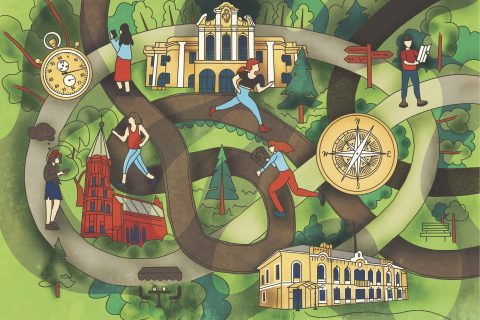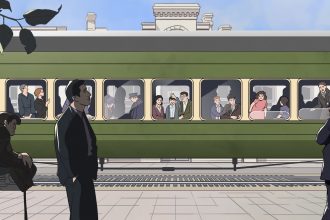When it comes to human entertainment, we could say that board games are one of its oldest forms. Their history dates back at least five thousand years, the times of the ancient civilizations. The long and complex development of games, the different cultural, social, and political circumstances have given birth to several dozen unique games. Some of them were forgotten or remained local, others like backgammon, chess, dice and so on, spread around the world.
People became interested in the history of Lithuanian board games quite recently. The first publications about chess appeared in the mid-20th century. At the end of the 20th century and beginning of the 21st century, different articles focused on dice, chess and other objects related to the topic that were found in Vilnius, Klaipėda, Kernavė and, of course, Kaunas.
Based on the archaeological data, we could say that chess, backgammon, nine men’s morris and alquerque have been known and liked in Lithuania since the 13th – 15th centuries and cards became popular in the 16th century. Written sources testify to the popularity of various board games in the 17th and 18th centuries among all social strata, yet there is still a lack of a more detailed information. The board game history of the 19th and early 20th century is also represented by just a few archaeological artifacts or historical exhibits.
Analysing the museum collections, the catalogues of the old bookstores and the advertisements in the periodical press, one can get a pretty good idea of Kaunas residents’ favourite board games of the first half of the 20th century. The research on the origins, rules, publishing, and distribution of these games can reveal the variety of board games, the extent of their popularity, and other aspects.
Museums and private owners have few remaining board games made in Lithuania or adapted to its market that date back to the first part of the 20th century. The situation with game and tarot cards is a bit different. Many are stored in the museums, the most valuables ones can be found at the M. K. Čiurlionis National Museum of Art and Lithuanian National Museum of Art. There you can see unique 19th and early 2-th century cards or their sketches made by Jonas Rustemas, Gotlybas Kislingas, Mstislavas Dobužinskis, Konstancija Petrikaitė-Tulienė, Petras Verbickas, Barbora Didžiokienė and other artists.
As for the games that were popular in Kaunas during the first part of the 20th century, we could say they could be divided into several main types. Various versions of the game Flirt could be assigned to communication games. This game that was very popular in Germany and Poland at the end of the 19th century, was commonly called the “flirt of flowers”. It is based on communication, on asking questions. Players are dealt cards with one question and ten or more possible answers. The card with an appropriate question is passed to another participant in the game, who answers it by choosing one right answer. The rules and advertisements for this game usually only briefly state that it is a “pleasant and fun game for youth” or even “a sincere conversation and expression of the secrets of the soul.” The similarly played game Flirt of Happiness, printed at Dirva publishing house in 1923, is stored at the M. K. Čiurlionis National Museum of Art.
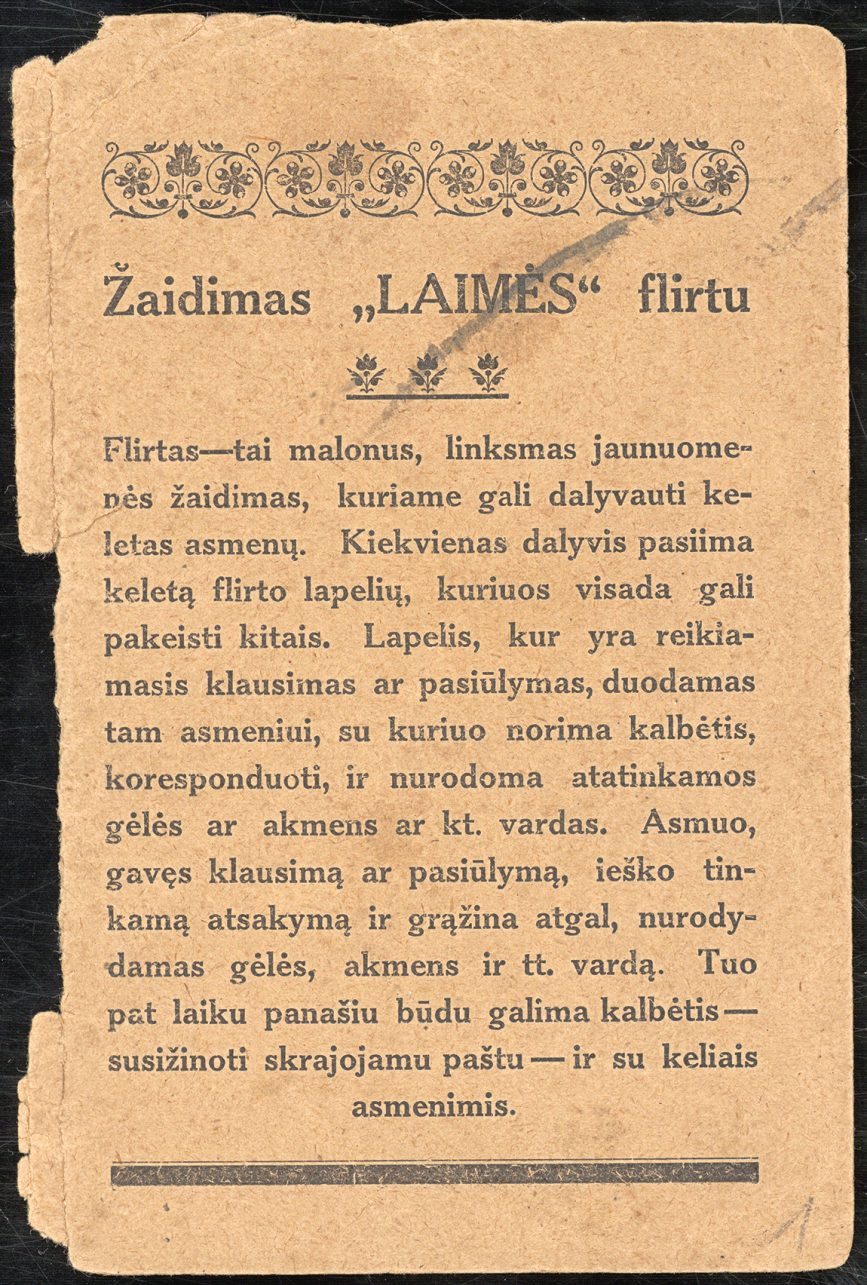
Many different games of chance were played in Kaunas in the first half of the 20th century. The goal of such game is to finish before your opponent does or to collect a certain number of points. Lotto is one of such games. Its history dates to 1530, when Lo Giuoco del Lotto D’Italia was started in Italy. Around 1770 the game was adopted by the French and around 1800 by Germans and so on. Various types of lotto were popular in Lithuania. For some time, there were mostly private lotto clubs favoured by adults. Some of them were banned by the government in 1924. However, it allowed the work of the clubs founded by charities. For example, Lithuanian Disabled Soldiers’ Union established a lotto club in Kaunas, which was supposed to raise funds for disability benefits. The Committee to Aid the Disabled Soldiers also had the same kind of club. After it turned out that the clubs were managed by private individuals, who paid only a certain fee for these organizations, their activities were stopped in 1925.
Although this game came in many forms, only the numbers lotto remained in the museums. They traditionally consist of 90 wooden barrels with numbers and cardboard cards with three rows of nine boxes with random numbers. The set also includes small cardboard or wooden disks to cover the numbers on the cards. The course of the lotto is simple: players draw a card and try to cover all the numbers on it first, considering the barrels drawn in turn. Today we know this game as Bingo.
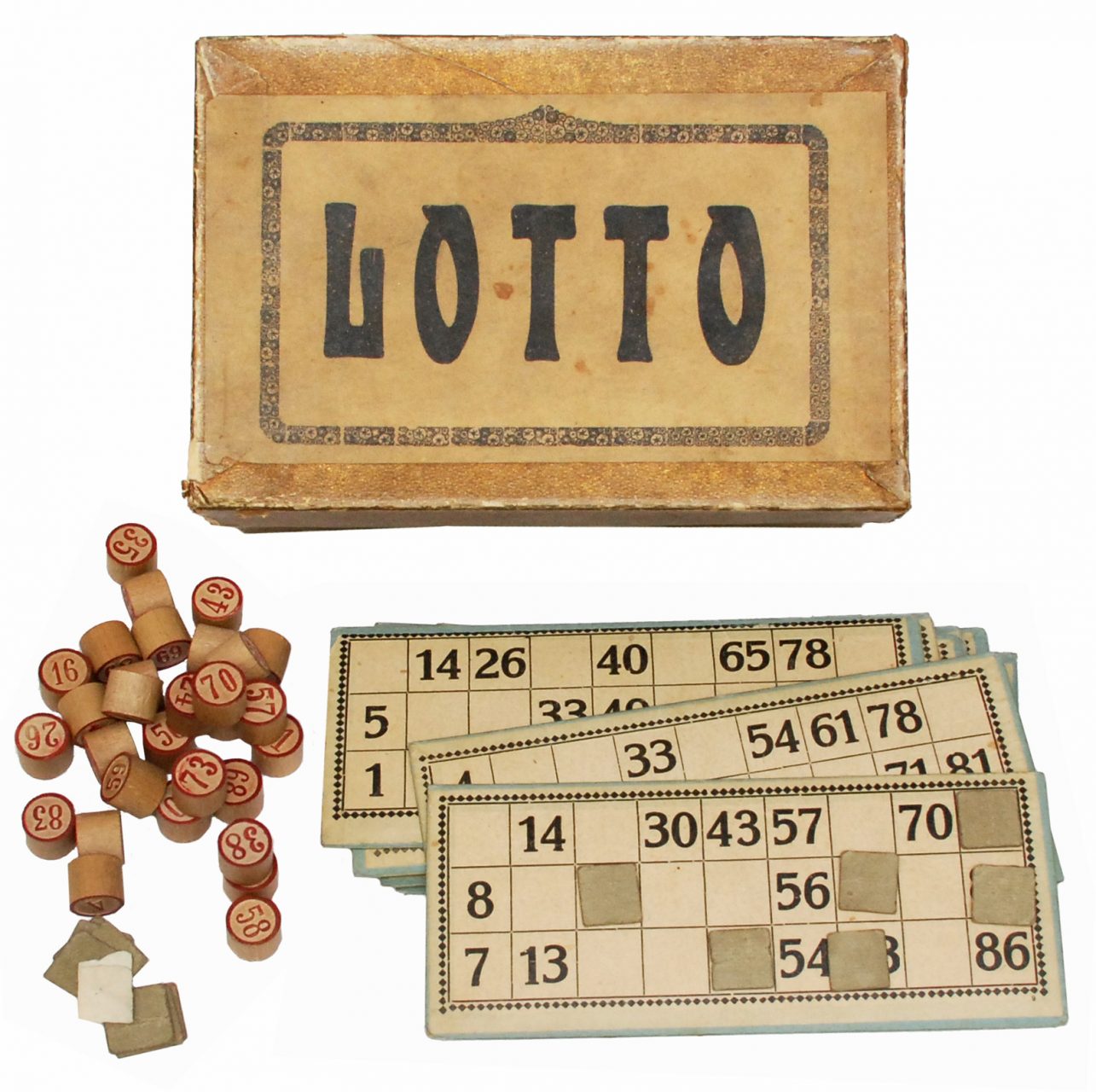
Snakes and Ladders as well as its variation Circus that spread in the first half of the 20th century also belong to the category of the games of chance. The board of this game is 12 × 10 boxes with numbers, which are connected in different directions by circus performers and animals, indicating how and where the player must climb up or down. This game has been played in India since the 2nd century AD and was adapted in England in the 2nd half of the 19th century and soon after in other countries. The content of the original game was related to the core principles of morality, its participants sought victory in an effort to overcome the path depicted on the game board as the equivalent of the path of life with virtues as ladders and sins as snakes. Virtues moved the player to a higher-numbered square and sins brought them to the lower-numbered square.
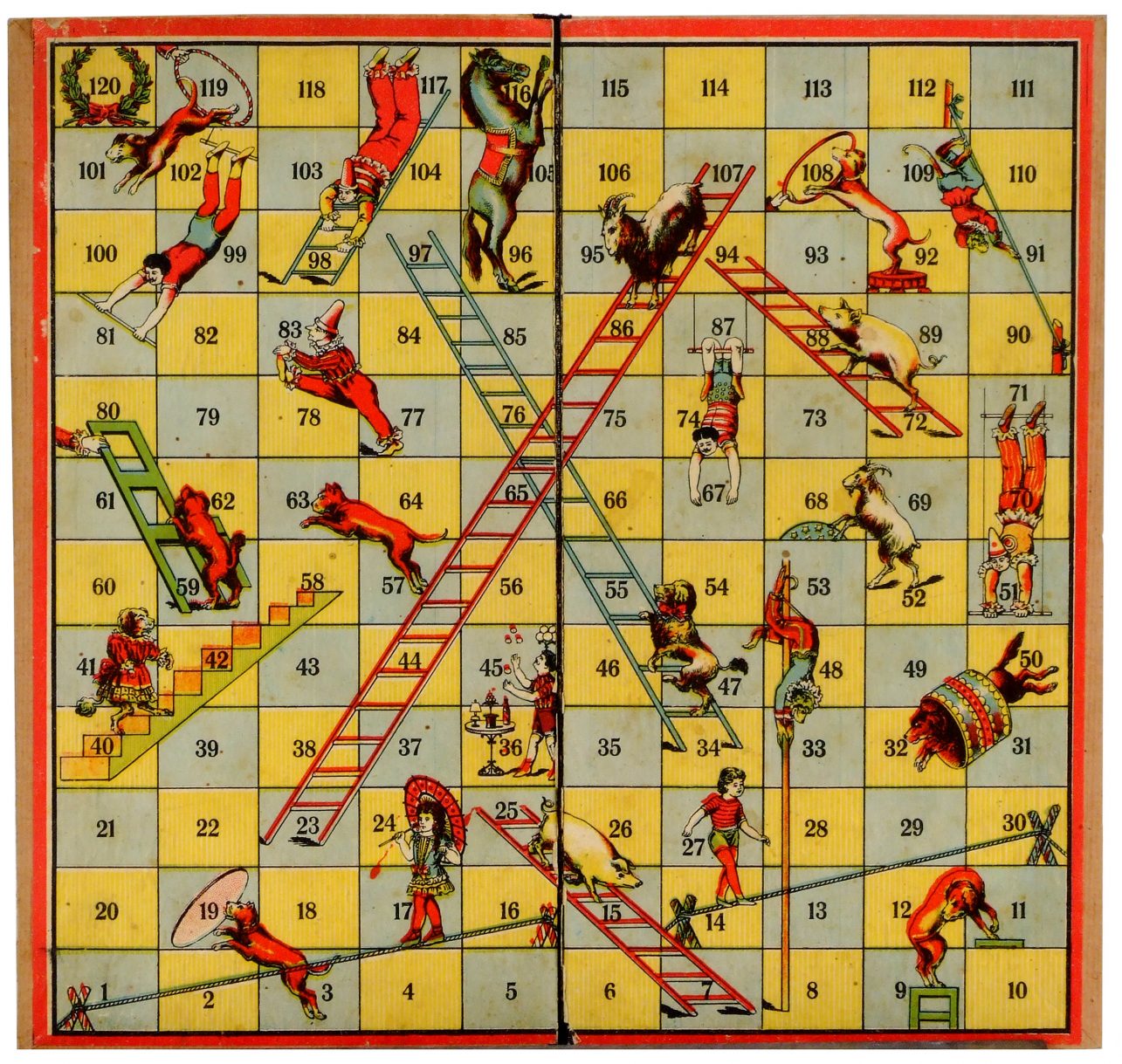
A game called Heaven is also similar to Snakes and Ladders. By rolling the die and moving through squares, the players must complete the route: by following the instructions provided they must reach heaven. Some squares depict virtues, others depict sins. Virtues help players move forward; sins hinder progress. One of the well-known versions of the game was published by M. Noreika (Lithography printing house in Kaunas). The second version of the game Heaven was published by Ona Vitkauskytė’s (1865–1928) bookstore and printed by M. Jolkas’ printing house. It should be mentioned that O. Vitkauskytė was an active cultural figure. Having established a bookstore in Kaunas in 1906 at her own expense, she printed various Lithuanian books, calendars, postcards, and, judging from the surviving copy of the game and plenty of advertising in the press, board games.
The game printed in Abraomas Ptašekas printing house is similar to the ones already mentioned. This is the only game where we detect a patent number and text warning not to copy the game. This suggests that printing houses would sometimes reprint or remake board games without permission. A. Ptašekas had invested in the publishing and distribution rights of the game in order to protect himself from the competition. A. Ptašekas (1859–1931) was a well-known bibliophile, who owned a bookstore and a warehouse of school supplies and paper, which was founded by his father Lozorius Ptašekas in 1866. The bookstore operated in Kaunas N. Vilniaus St. 6 (currently Vilniaus St. 35).
In addition to the game Heaven, A. Ptašekas published and sold at least one more game called the Lucky Twelve. The gameboard of this game consists of ten squares arranged in a circle with numbers from 2 to 11 with different symbols. A chimney sweep with a ladder and a piglet under the arm is depicted in the centre of the board. Two dice were used for the game, and players, like in roulette, would bet matches for a chosen number. Considering the styling of the board and the course of the game, it can be said that Lucky Twelve is an adapted and simplified version of a popular German game of the 1920s – 1930s Hans im Glück (Happy Hans).
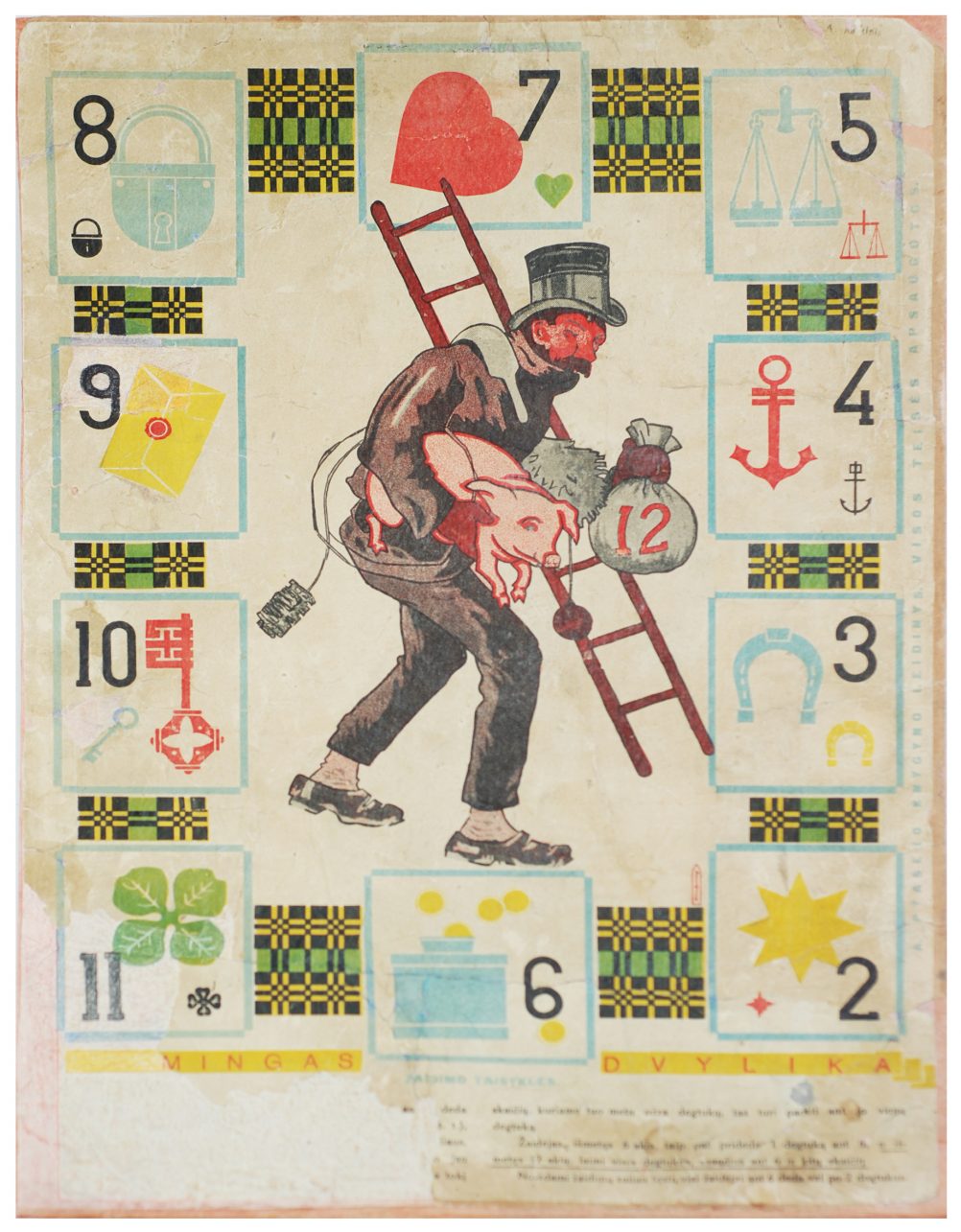
Press is an important source of the game history of the first half of the 20th century. During the mentioned period, a wide variety of publications were published: dailies, magazines, catalogues, a wide range of books, and encyclopaedias. Information about games and their prices can be found in the advertising catalogues of department stores and mainly bookstores.
In 1910, while Lithuania was still part of Tsarist Russia, J. Naujalis, in addition to the board games Heaven and Flirt, offered customers to buy the Magicians’ Cards in his bookstore in Kaunas, which, just like the other games, were printed in Riga. All of the mentioned goods could be found in Kazimieras Rutskis bookstore for an identical price.
After Lithuania declared its independence, local products also appeared in bookstores. For example, Dirva Bookstore, which had branches in Kaunas and Marijampolė, in its catalog of the school year 1928–1929, offered its customers a game of flirts called Luck for 2 litas and 60 cents. Liudas Jakavičius’ Lietuva Bookstore catalog that appeared around 1929, offered a game Flirt for 2 litas and 50 cents. According to its makers, it was a “game of love.” In 1932, in J. Karvelis and J. Rinkevičius bookstore in Kaunas people could purchase a chess set. And a systematic catalogue of Lithuanian books, published in 1938, states that A. Ptašekas had published a flirt Luck, which costs 2 litas, and magic cards that cost 1 litas and 50 cents.
Board games were available not only in bookstores but also in various other shops. For example, the catalog of the Lithuanian universal commerce Eureka advertises several types of lotto games. The “geographical” cost 3 litas and the “zoological” cost 3 litas and 50 cents and the one with the barrels and cards cost 5 litas. The shop also sold checkers, chess, and dominoes “of all sizes.” Children and adults could buy a Monte Karlo “roulette” for 1 litas and 50 cents and a flirt for one litas. Game and Toy book published by Ona Narušytė (Januševičienė) in 1937, states that remembering various scientific disciplines and individual subjects contributes to the development of children’s mental function. According to her, various lotto and other board games are suitable for this. The author provides the Lithuanian Academic Lotto – a German geographic and exotic animal lotto – as an example. She mentions that it is sold in a shop called Žaislas located in Kaunas Laisvės Ave. 36. The book mentions that chess and checkers, which contribute to the development of children’s mental capacities, can be acquired in Žaislas Store as well as Marginiai Cooperative stores.
As for visual advertising in the newspapers and magazines of the first half of the 20th century, it should be noted that only toy stores, which also sold board games, were usually advertised. There were not many individual board games’ advertisements in the press. Only a few of them can be found next to the list of sold books in the aforementioned bookstore catalogs. In contrast to the richly illustrated toy store advertisements, board game ads only stand out due to their font, sometimes they are framed, have a modest picture. Newspaper advertisements differed only slightly from the latter in terms of design.
Finally, it is gratifying to know that as the interest in everyday history increases, various objects of entertainment become attractive not only to specialists but also to the general public. The valuables stored in museum collections and library shelves reveal a wide variety of games played by Kaunas residents of the first half of the 20th century. It is becoming clear that the main producers and distributors of board games in Lithuania were bookstores, although it was possible to find them in toy and department stores as well. It is interesting that since 1905, after the ban on the Lithuanian press was lifted, board games in Lithuanian were publicly distributed. In 1920s the number of board games in Lithuanian significantly increased; they were being printed locally. In 1920s and 1930s active competition emerges, game advertisements in the press increase and there are even legal disputes regarding board games.


